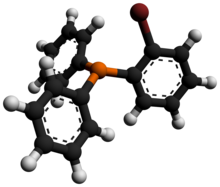(2-Bromophenyl)diphenylphosphine

| |

| |
| Names | |
|---|---|
| Preferred IUPAC name
(2-Bromophenyl)di(phenyl)phosphane | |
| Other names
(o-Bromophenyl)diphenylphosphine
| |
| Identifiers | |
3D model (JSmol)
|
|
| ChemSpider | |
| EC Number |
|
PubChem CID
|
|
| UNII | |
CompTox Dashboard (EPA)
|
|
| |
| |
| Properties | |
| C18H14BrP | |
| Molar mass | 341.188 g·mol−1 |
| Appearance | White solid |
| Melting point | 115 °C (239 °F; 388 K) |
Except where otherwise noted, data are given for materials in their standard state (at 25 °C [77 °F], 100 kPa).
| |
(2-Bromophenyl)diphenylphosphine is an organophosphorus compound with the formula (C6H4Br)P(C6H5)2. It is a white crystalline solid that is soluble in nonpolar organic solvents. The compound is used as a precursor to the 2-lithiated derivative of triphenylphosphine,[1] which in turn is a precursor to other phosphine ligands.
Preparation
[edit]The compound has been prepared by several methods.[1] An efficient route is the coupling reaction of diphenylphosphine and 2-bromoiodobenzene, which is catalyzed by palladium complexes (Ph = C6H5):[2]
- C6H4Br(I) + HPPh2 + Et3N → Ph2P(C6H4Br) + [Et3NH]I
The compound is isomorphous with (2-tolyl)diphenylphosphine.[3]
Lithiation with butyl lithium gives o-lithiated triphenylphosphine. The bromide also forms a Grignard reagent. These metallated phosphines are versatile reagents.[4]
- BrC6H4PPh2 + Mg → BrMgC6H4PPh2
- 2 BrMgC6H4PPh2 + PhPCl2 → PhP[C6H4PPh2]2 + 2 MgClBr
References
[edit]- ^ a b Bennett, Martin A.; Bhargava, Suresh K.; Hockless, David C. R.; Welling, Lee L.; Willis, Anthony C. (1996). "Dinuclear Cycloaurated Complexes Containing Bridging (2-Diphenylphosphino)phenylphosphine and (2-Diethylphosphino)phenylphosphine, C6H4PR2 (R = Ph, Et). Carbon−Carbon Bond Formation by Reductive Elimination at a Gold(II)−Gold(II) Center". Journal of the American Chemical Society. 118 (43): 10469. doi:10.1021/ja961511h.
- ^ Zhang, Fushi; Wang, Liduo; Chang, Shih-Han; Huang, Kuan-Lin; Chi, Yun; Hung, Wen-Yi; Chen, Chih-Ming; Lee, Gene-Hsiang; Chou, Pi-Tai (2013). "Phosphorescent Ir(iii) complexes with both cyclometalate chromophores and phosphine-silanolate ancillary: Concurrent conversion of organosilane to silanolate". Dalton Transactions. 42 (19): 7111–9. doi:10.1039/c3dt32408g. PMID 23518610.
- ^ Williams, Michael L.; Noack, Cassandra L.; Saverin, Rodney J.; Healy, Peter C. (2002). "(2-Bromophenyl)diphenylphosphine". Acta Crystallographica Section E. 58 (3): o306 – o307. doi:10.1107/S1600536802002945. hdl:10072/6976.
- ^ Hartley, J. G., Venanzi, L. M., Goodall, D. C., "The preparation and complex-forming properties of one tritertiary and one tetratertiary phosphine", J. Chem. Soc. 1963, 3930. doi:10.1039/JR9630003930
